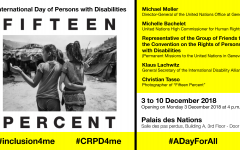OHCHR in partnership with artist photographer, Christian Tasso, will hold an exhibition entitled “FifteenPercent” to be opened on the International Day of Persons with Disabilities....
Click here to go to the English audio description, or scroll down for:
-> The project
-> The Author
---> Go to picture number 1, 2, 3, 4, 5, 6, 7, 8, 9, 10, 11, 12, 13, 14, 15, 16, 17, 18, 19
Like never before, media holds a powerful and present force in the daily lives of every citizen of the world. It plays a significant role in telling stories and shaping the images of individuals and groups within our society. Today, media continues to portray persons with disabilities as passive victims in need of treatment, charity and benevolence. Where there may be a rare positive headline concerning them, commonly the message is equally misinformed, depicting them as superheroes having surmounted the “unsurmountable” to accomplish a feat which society never expected of them. These stories continue to have at their base the division of “us” and “them”, absent of a shared humanity.
With the adoption of the United Nations Convention on the Rights of Persons with Disabilities (CRPD), whose 10th anniversary of entry into force we celebrate this year, a paradigm shift has taken place to discard the charity and medical approach to persons with disabilities and to adopt a human rights based approach which recognizes their rights and calls for and values their participation and inclusion in society.
FifteenPercent is a photography project about persons with disabilities across the world which commenced in 2015. It is entitled “FifteenPercent” because this is the proportion of the world’s population which is made up of persons with disabilities as estimated by the World Bank and World Health Organization.
Every frame of the project is centered on the personal story of the subject first and foremost as an individual within their personal sphere of attitudes and ambitions. Their disability becomes just one element among many which make up their identity. FifteenPercent aims at portraying the multiple facets and identities of humanity as a celebration of difference and diversity and seeks to raise awareness and understanding that our communities are ever enriched by the diversity of its members, be they persons with disabilities, women, youth, older persons, and all other groups. And our communities can only be strengthened by ensuring the inclusion of each of its members.
In celebration of 70 years of the Universal Declaration of Human Rights (UDHR), the exhibition serves as a call to embrace diversity as part and parcel of humanity. The portraits illustrate responses to the question posed by Eleanor Roosevelt, one of the drafters of the UDHR :
“Where, after all do universal human rights begin?
In small places, close to home - so close and so small that they cannot be seen on any maps of the world. Yet they are the world of the individual person; the neighborhood he lives in; the school or college he attends; the factory, farm, or office where he works. Such are the places where every man, woman, and child seeks equal justice, equal opportunity, equal dignity without discrimination. Unless these rights have meaning there, they have little meaning anywhere. Without concerted citizen action to uphold them close to home, we shall look in vain for progress in the larger world.”
The stories that compose the work derive from: Italy, Ecuador, Romania, Nepal, Germany, Albania, Cuba, Mongolia, India, Kenya and Cambodia.
#CRPD4me #Inclusion4me #ADay4All #FifteenPercent #UDHR70 #Standup4humanrights @FifteenPercentProject (Instagram) @unitednationshumanrights (Instagram) @UNHumanRights (twitter)
“The Convention on the Rights of Persons with Disabilities includes accessibility as one of its key underlying principles — a vital precondition for the effective and equal enjoyment of civil, political, economic, social and cultural rights by persons with disabilities. Accessibility should be viewed not only in the context of equality and non-discrimination, but also as a way of investing in society and as an integral part of the sustainable development agenda.”
- General Comment no 2 on accessibility, Committee on the Rights of Persons with Disabilities
Accessibility features have been embedded into the exhibition in an effort to render the works and message accessible to a wide range of people:
- The captions of the photographs are also presented in Braille. Braille is a system of raised dots that can be read with the fingers by people who are blind or who have low vision.
- QR codes accompanying the exhibition lead to audio descriptions of the images appearing in the photographs for people who are blind or who have low vision. The audio descriptions are available in the UN languages: English, Arabic, Chinese, French, Spanish and Russian.
- Large print formats of the exhibition’s texts are available for persons who have low vision also in different languages.
- The video displayed in the exhibition features captioning for persons who are hard of hearing and deaf persons.
Christian Tasso is an independent artist and photographer, born in Italy in 1986.
Mainly self-taught, he devoted himself to professional photography starting in 2007 with his first project entitled "The Last Drop", for which the following year he won the "Fotoleggendo" award in Rome. For six months, he lived and worked with a family of farmers from the Marche region in Italy, and recounted their daily life through images. This first project opened up his curiosity for the themes which continue to accompany his work til today, such as: community customs and rituals, the search for identity through and with others, the interaction between humanity and nature, the relationship between memory and territory.
Commissioned by an Italian NGO in 2009, Christian began the "Saharawi" project documenting the lives of people with disabilities in Western Sahara. From this experience the photographic project "Nothing and so be it" was conceived, for which he won the award of "The Aftermath Project" in Los Angeles in 2011. His experience in the Sahara inhabited him throughout the following years, leading him to return there several times to give voice to the local population through his images.
In 2013, Christian rented an apartment within the largest multi-ethnic apartment block in Italy, known as “Hotel House”. This building complex, which became a frequently covered case in the media, is described as a ghetto in which violence and criminality are distributed across sixteen floors and which is home to over thirty different ethnic groups living together. Christian photographed the residents for two months, telling their stories of search and survival. Having been accepted into their community, he organized a photography course for the children and adolescent tenants, which culminated in an exhibition with the support of Social Funds of the European Community.
Following the experience of Hotel House, Christian devoted himself almost exclusively to long-term projects. In 2016, he made the documentary "MadrEmilia" commissioned by the University of Modena and Reggio-Emilia which focused on the life of Pier Vittorio Tondelli, an Italian writer who was commonly censored for writing about homosexuality. The film was distributed by RAI, Italy’s main television station.
In 2015, he launched “FifteenPercent” which documents the lives of persons with disabilities around the world. The project was published in a limited edition book and exhibited in Italy (Venice and Milan) and Belgium (Tournai). The complete book of the project will be published in 2019 and will be distributed together with the continuing tour of the FifteenPercent exhibition.
For more information, please visit: www.christiantasso.com
1. Photograph of a Masai man, Kenya, 2017
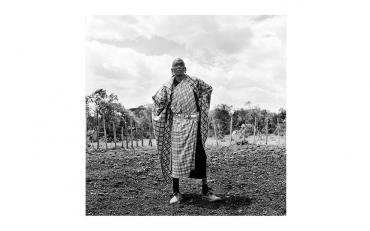
Photographic image in black and white, printed on canvas.
Measures 150cm x 150 cm
The image represents a standing man with arms akimbo. His figure stands out in the centre of the image, in a proud and determined pose. The gaze is directed to the viewer of the image. The head is shaved and the ears have an elongated shape due to the use of traditional Masai earrings, oval wooden discs that widen the lobes creating a hole of two or three centimeters.
The man's dress consists of a square cutout of fabric, which is folded into several layers and draped in various ways. The upper part, which covers the shoulders and descends on the back like a cloak, has a checkered pattern, made up of repeated squares of different dimensions.
The underlying layer, a different, lighter fabric drapes down from the neck to the knees, supported at the waist by a beaded belt.
His shoes are consumed by years of work of. The ground on which the man is standing has long been sowed, there is no grass, only earth and stones.
In the background, in the middle of the photograph there is a fence, a set of irregular wooden poles separates the field from the forest. It is there to prevent the animals from fleeing.
In the background are lush trees and the sky with some clouds.
A phrase accompanies the photograph, it is a quote of the man depicted, which says:
"I have sixteen children and I have my herd. I have always done my duty, my disability is not a problem.”
***
2. Photograph of a shaman, Mongolia 2017
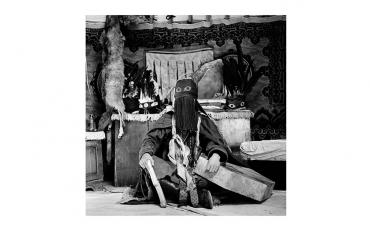
Photographic image in black and white, printed on canvas.
Measures 150cm x 150 cm
The image represents a person sitting on the floor of their home with legs crossed and facing the viewer. It is a Mongolian shaman.
The house is a Yurt, a typical tent, which has an octagonal plan, used by most of the nomadic population of Mongolia.
The face is covered by a mask: this mask is composed of a top layer of compact fabric that covers the face up to the mouth, and a lower part composed of many thin threads that move with each movement of the body. At eye level, the mask has two patches of fabric depicting eyes, at the location of the eyes, very large and looking in opposite directions.
The person wears a dark cloak, a rolled leather scarf extends down to their feet. They wear a wooden necklace and leather boots. Because the head and body are covered, it is not possible to distinguish whether the shaman is a man or woman.
The right hand holds a stick, while the left is resting on an animal skin drum. Stick and drum are used during the shamanic ritual to create a rhythm of increasing percussion that causes the shaman to enter into a trance.
In the background, there is the wall of the Yurt. It is composed of woolen carpets of various patterns, used as tapestries to insulate from the cold of the steppe. In fact, here the winter temperatures fall well below minus twenty degrees.
Behind the subject is a wooden piece of furniture.
On the left side, we can glimpse the skin of a wolf, all the shamans have wolf skins at home, to represent the connection with nature and the warlike relationship with the animal, as in winter wolves fight with the nomads to get to the flocks of domestic animals.
On the side of the wolf skin, above the piece of furniture, different types of headgear are resting on top of each other. They have different shapes from the one worn by the protagonist of the photo. Above them you can count numerous bird feathers, they are used for other types of ritual.
A phrase accompanies the photograph, it is a quote from the person who says: “I am a shaman, this means that the spirits of ancestors visit my body to talk to me and my neighbours. They give us advice to help us live a better life. You cannot choose to be a shaman, nor can others choose for you. It is the spirit that chooses you, no matter who you are- if you are a man or a woman, or whether you have a disability or not.”
***
3. Portrait of two young girls, Italy, 2017
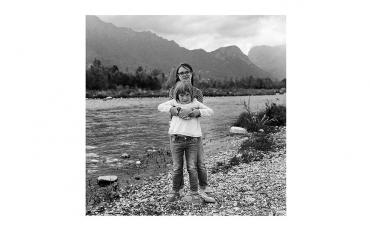
Photographic image in black and white, printed on canvas.
Measures 150cm x 150 cm
The image represents two young girls around 6 and 10 years old respectively. They on the banks of a river coming down from the Dolomite mountains in the north of Italy, near Belluno, in the region of Veneto.
At the centre of the photograph, full-length, both girls are standing facing forward. The taller girl wears glasses and has her arms wrapped around the younger girl who stands in front of her and who is at the same time being lifted off the ground by the taller girl’s embrace. They both wear jeans and sneakers. The girl in front wears a white T-shirt, while the one in the back wears a checkered shirt.
At their feet, a beach of stones make up the riverbed, the river is running behind them.
On the other side of the river, starting from the bank, a forest cuts the frame, behind it are clearly visible the shapes of the high mountains, covered with puffy and grey clouds. The top of some of those mountains seem to have some snow left from the winter that finished a couple of months before.
A phrase accompanies the photograph, it is a quote from the taller girl in the back that says:
“I love to sing, play tennis and watch funny videos on YouTube.”
***
4. Portrait of a girl, Cambodia, 2016
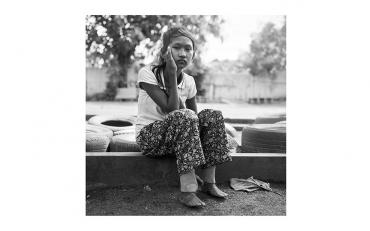
Photographic image in black and white, printed on canvas.
Measures 150cm x 150 cm
The image represents a 13 year old girl sitting on a low wall while she turns her gaze to the photographer.
The wall on which she is seated is made of cement, and some cracks mark it. On the left side of the frame a large leaf is resting on the ground.
The girl wears a pair of flowy floral pants and a white polo shirt, her left arm is folded, and with the other one she is holding her ear. The elbow of her right arm is resting on her knee and her hand is supporting her head accompanying her intense gaze.
From the ends of her trousers rest two wooden prostheses in the shape of feet. It is difficult to distinguish whether they are prostheses or not.
Behind the girl and just behind the low wall, a series of tires are left to melt under the sun, while in the background a wall and trees connote the park in which the scene was taken.
A phrase accompanies the photograph, it is a quote from the protagonist of the picture that says:
“I like to play here with my friends in the garden. We come here every day after school.”
***
5. Photograph of a Masai woman, Kenya, 2017
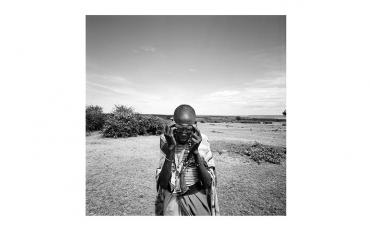
Photographic image in black and white, printed on canvas.
Measures 150cm x 150 cm
The image represents a woman standing, facing the photographer, wearing a pair of glasses, between them and her eyes the woman has just put a blindfold to protect her eyes from the dust of the savannah.
The woman has a shaved head, her clothes are light, a cape with patterns and designs that are difficult to recognize because of the folds that cover her shoulders. She wears a t-shirt with horizontal stripes underneath, and at her neck a necklace of small wooden and plastic beads, the same beads make up the two bracelets that the raised wrists put in full view. On her waist a wide band made of fabric wraps the t-shirt and the underside of her dress.
The horizon cuts the photograph into its exact half, leaving the clear and cloudless sky at the top, while in the lower part, behind the woman, sparse vegetation and some trees can be seen in the background, up to the horizon, letting you sense the dryness of the savannah, where it rains very rarely.
A phrase accompanies the photograph, it is a quote from the woman, who says:
“While my children are in the field tending to the herds, I manage the house and our animals and prepare the meals for the whole family.”
***
6. Portrait of women, India, 2017
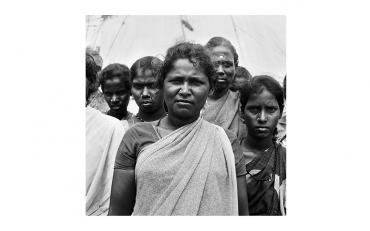
Photographic image in black and white, printed on canvas.
Measures 150cm x 150 cm
The image represents a group of women who look proudly toward the photographic lens.
It is a narrow plane, the woman in the foreground is portrayed from the upper part of her torso. Not all the faces of the protagonists are included fully in the frame, some are only seen by some traits, some of them are half hidden behind the other companions.
The woman in the foreground has a strong and serene look. Her poise is straight.
She wears a traditional dress with a flowery pattern covering one shoulder, underneath it she wears a dark T-shirt. She has a nose ring, like all the other women represented in the picture.
They are part of the Irula tribe, their ancestors were renowned snake hunters throughout India. Today their community lives mainly on farming.
Behind the woman a series of other faces distinguish the focal planes of the image, all with a fixed gaze directed at the viewer.
A phrase accompanies the photograph, it is a quote from the protagonists that says:
“This is our way of life: in our tribe nobody is excluded.”
***
7. Portrait of a man, Kenya, 2017
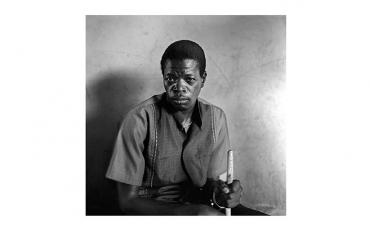
Photographic image in black and white, printed on canvas.
Measures 150cm x 150 cm
The image represents a man sitting with a stick in his hand.
He wears a shirt, and he looks straight toward the viewer.
This person is a self-advocate from the Kenya Association of the Intellectually Handicapped, portrayed while on break during a one-day training.
His hair is shaved close to his head and the wrinkles on his face outline a serious and proud expression. His left hand holds a light stick, his fingers hold it tight.
In the background a grey wall with numerous signs and lines.
A phrase accompanies the photograph, it is a quote from the protagonist who says:
“I fight every day in my community to see my rights respected.”
***
8. Photograph of a father and his son, Kenya, 2017
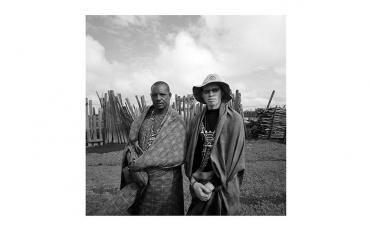
Photographic image in black and white, printed on canvas.
Measures 150cm x 150 cm
The image represents two men.The one on the left side of the picture is older and has dark skin, the other is younger and visibly fairer skin: he is a person with albinism.
The two are standing side by side in the centre of the frame and looking directly at the viewer. The man on the left wears a dress made of a big cloak that wraps around his body, with a checked pattern and a very large necklace. His head is bare and shaved.
A gust of wind moves the lower part of his dress, which he holds tight with his two hands crossed under the fabric.
To his right, the younger man looks at the camera in a more relaxed pose. His hands are crossed in his lap. Wearing a dress similar to that, but without a pattern. Underneath he is wearing a black T-shirt and a very elaborate necklace, which occupies almost half of his torso. He wears a wide hat and a pair of sunglasses.
In the background, in the upper part of the photo, white clouds fill the sky.
In the lower part, behind the two subjects, a fence made of irregular wooden planks is visible: each piece is very close to the other, almost creating a compact barrier to protect livestock from wild animals, very numerous in this area.
A phrase accompanies the photograph, it is a quote from the younger man depicted in the photograph, who says:
“People who know me appreciate me.”
***
9. Family portrait, Nepal, 2015
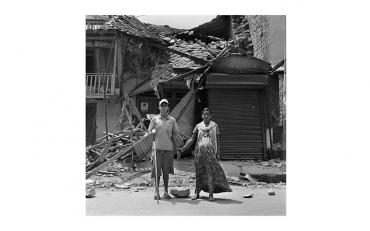
Photographic image in black and white, printed on canvas.
Measures 150cm x 150 cm
The image represents a man and a woman holding hands side by side as they look towards the viewers. Behind them are the ruins of a house; half of the building collapsed because of the strong earthquake that hit Nepal in 2015.
The man holds a stick, a white cane, firmly with his right hand. He wears leather sandals, shorts and a t-shirt. He wears a cap and his eyes are half closed. His left arm descends to his side and is gripped on the wrist by the hand of his bride.
She is wearing cloth shoes and a long flowered dress. A light cotton scarf is wrapped loosely around her neck and reveals a necklace made of wood beads.
A breath of wind swells her dress towards the right side of the frame, this movement of the fabric allows a glimpse of the woman's pregnant belly; soon the two will have their first child.
Behind them, on the left side a wooden balcony has remained intact, while the rest of the building, behind the couple, has lost its original shape to leave space for a pile of shapeless rubble of which the only part left intact, in addition to the balcony, is the metal shutter of a garage.
A stone of the house has rolled up to the road, you can notice it between the feet of the couple.
A phrase accompanies the photograph, it is a quote from the man that says:
“One day I met her, and we fell in love. My neighbours didn’t believe me when I told them that I was going to marry. Today we are expecting our first son.”
***
10. Photograph of a school class, Nepal, 2015
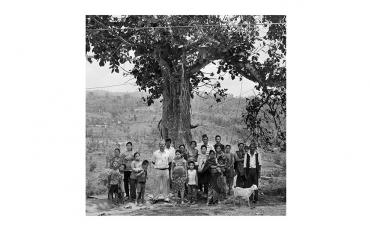
Photographic image in black and white, printed on canvas.
Measures 150cm x 150 cm
The image represents a group of people standing under a large tree, all facing the viewer.
On the left side of the frame two mothers look at the lens from behind their two children, the latter are intent on looking at the lens while one of the other two turns to the right while his sister hugs him.
At the centre of the scene is a man dressed in white, he is the director of the school.
Among the group of 15 people, are children and adults who look at the lens some with expressions of joy, some with a serious expression. On the right side, a white goat also seems to pose for the photographer.
The soil is dry, you can sense the hot season and the dryness of the land. In the background, a hill with scattered trees can be glimpsed, in some points some terracing leaves giving hits of the intervention of the farmers of the area.
The protagonists of this shot pose in the shade of a large tree, of which you can clearly see the trunk rising up the centre of the scene and reaching a space of large foliage, in some points not too thick.
A phrase accompanies the photograph, it is a quote of the man depicted, which says:
“The earthquake destroyed our school. We will start building it again as soon as we can. For now, we take our lessons here, under the tree in front of the fallen building so our children learn that we must persevere to find our way in life.”
***
11. Photograph of a barber, Cambodia, 2015
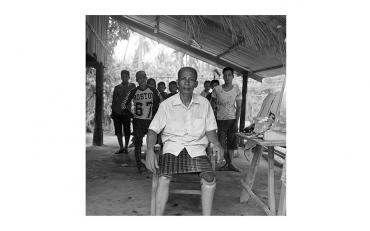
Photographic image in black and white, printed on canvas.
Measures 150cm x 150 cm
The image represents a barber, portrayed outside his home, where he works every day.
In the image the protagonist is seated in the foreground. He wears a short-sleeved shirt and a traditional cloth made of a simple checked fabric wrapped around the lower part of his body which descends up to his knees and reveals his prosthesis. Below his left knee is a prosthesis. On his left is a wooden craft table, above which you can clearly see a mirror and the tools of his craft.
Behind him, a meter away, eight boys of different ages look in the direction of the photographer, posing for photography.
The image is taken under a tin roof, present in the upper part of the frame.
In the background, you can see the tropical forest typical of the area where the photo was taken.
A phrase accompanies the photograph, it is a quote of the man depicted, which says:
“I was in the military and served in the war. Now I have a barber shop in front of my house. All the youngsters of the village pass time with here, we talk and play pool together. My yard has become the centre of the village.”
***
12. Portrait of a man surrounded by nature, Italy, 2018
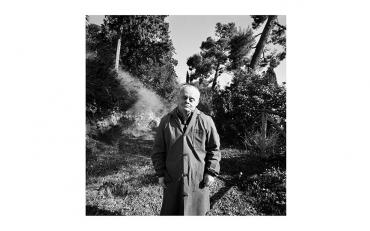
Photographic image in black and white, printed on canvas.
Measures 150cm x 150 cm
The photograph represents a man standing in a wooded park.
He is standing facing the viewer, while the head is slightly inclined on one side, almost following the inclination of the trees all around, in a pose that expresses calm and mindfulness. His eyes are closed.
The man wears a long sleeved and long work coat, buttoned up just below the neck, where you can see the top of his sweatshirt, the arms are straight along the bust.
On the right and left sides of the image are the presence of some bushes and a fence which create a perspective that suggests the presence of a path in the middle of the trees.
At the top, you can see the foliage of conifers, bent all in the same direction by the wind.
A phrase accompanies the photograph, it is a quote from the depicted man who says:
“I like to work the wood.”
***
13. Family portrait, Ecuador, 2015
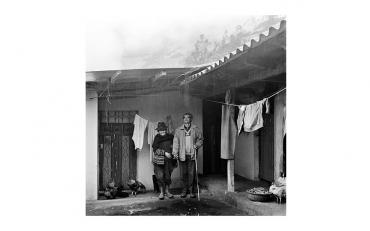
Photographic image in black and white, printed on canvas.
Measures 150cm x 150 cm
The photograph represents a man and a woman holding hands side by side in front of their own house, who observe the rain while they are protected by a shed tin roof.
It is a wide shot, the two figures are in the lower half of the photograph, they wear long pants, rubber boots, both have a woollen sweater, the woman wears a circular hat and she looks straight at the viewer. The man wears a cap and a pair of sunglasses, his gaze is directed above to his right, as if watching the sky, and with his left hand he holds a white cane.
To the left of the couple, three dark hens are portrayed in front of one of the doors of the house. Above the door you can see a metal roof, which cuts the image from one side to the other.
On the right side of the subjects, always sheltered by the roof, two white hens stand in front of a circular container full of freshly picked vegetables.
At the top, in front of a second door of the house, a thread holds clothes hanging to dry.
At the top of the frame, above the sheet metal canopy, a series of thick clouds reveal the shapes of some plants and the slope of a mountain.
Small trails of rain pass through the frame in the vertical direction, becoming more visible in the dark areas of the picture.
A phrase accompanies the photograph, it is a quote from the depicted man who says:
“We finally have the phone line in our village- now I can call my son in Quito.”
14. Portrait of an activist and his personal assistant, Nepal, 2015

Photographic image in black and white, printed on canvas.
Measures 150cm x 150 cm
The image represents two men in profile, the framing close to the torso of the two lets us see that the man behind is carried on the back by the man in front.
The man in front is wearing a light-coloured t-shirt, short hair and a straight forward face looking determinedly ahead. The sunlight illuminates his face. He wears a baseball cap with a visor turned backwards.
The man behind him wears black trousers, visible in the lower part of the frame and a small checkered shirt. His arms are around the neck of his bearer, stiff and elongated, the two hands hook to create a firm grip and remain balanced.
The man has a backpack, of which the numerous pockets and zips are visible. His face is serene and proud, he wears dark-rimmed glasses.
In the background, you can see the silhouettes of mountains full of vegetation on the steep slopes, which leave space, one after the other, to the snowy peak of Mount Annapurna, one of the highest mountains in the world (its altitude exceeds 8000 meters on the level of sea).
A phrase accompanies the photograph, it is a quote from the depicted man who says:
“I know that to better promote our rights, we need to know what the reality is. So, I go up to the mountains to gather information about people with disabilities who are living in those remote areas.”
15. Portrait of a mother and her son, Cambodia, 2017
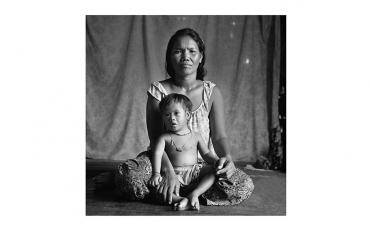
Photographic image in black and white, printed on canvas.
Measures 150cm x 150 cm
This image represents a mother and her child, sitting in frontal pose and looking directly at the viewer.
The woman wears loose trousers, with patterns of various shapes, and is sitting on the ground with her legs bent, on the left side of the image her foot is visible. She wears a tank top of light fabric and her face, illuminated by a side light that enters from the door of the house, is directed to the viewer with a fixed and serious gaze.
Her legs are enlarged to make space for the child, sitting in front of his mother. The woman's right arm extends forward touching the child's right ankle, while the left arm, resting on the knee, on the other side, in a protective gesture.
The child is topless and wears a pair of shorts and the gaze directed at the spectator in a curious and serene pose. At the neck a small necklace of fabric and wooden beads.
In the background, you can see a curtain, with floral patterns that is used as a divider inside the house. Some folds delineate the shape, creating the feeling that the image was taken in a photographic studio.
A phrase accompanies the photograph, it is a quote from the depicted woman who says:
“My son will grow up in his home, in his community.”
***
16. Portrait of a woman, India, 2017
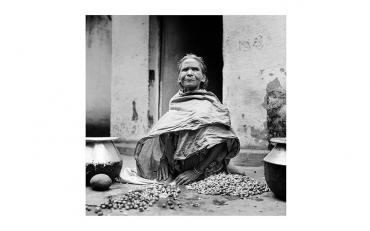
Photographic image in black and white, printed on canvas.
Measures 150cm x 150 cm
The image represents a woman photographed during working hours. She is in a squatted position on the ground with coffee beans spread out before her. Her gaze is directed at the viewer, the head in an upright position.
The woman wears a fabric that is wrapped around her in a circular manner, covering her torso and leaving the hands free to work. She wears pearl bracelets on her wrists.
Her hands are placed downward, above the feet. Around her hands, on the ground, two small piles of coffee beans suggest the type of work done at that moment by the woman: the division of the beans. Two metal amphorae at the right and left ends of the frame give symmetry to the photographic composition.
Behind the woman there is the white wall of her house and the door is open. The paint of the wall is not homogeneous, the signs of time have left marks more or less dark.
A phrase accompanies the photograph, it is a quote from the depicted woman who says:
“My brother is the last honey hunter of the area, it is dangerous work and I help him every day.”
***
17. Portrait of a woman, Ecuador, 2015
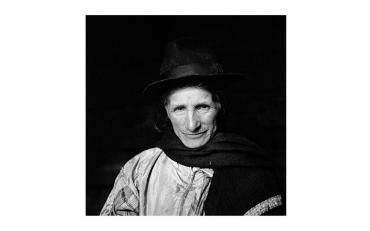
Photographic image in black and white, printed on canvas.
Measures 150cm x 150 cm
This photograph represents the close-up of a woman on a black background.
The gaze is directed at the spectator, in a proud, serene and relaxed pose.
The woman wears a hat with a circular shape, made of fabric, a band of shiny leather which divides the two parts of the headgear.
A coloured fabric sweater with a central zip covers the left side of the woman's torso, while on the right a cloak, wrapped like a scarf around the neck, also covers the shoulder and goes down to cover the right side of her body.
The bright light illuminates her face and clothes, while all the rest is completely black, bringing out the figure of this woman from the darkness.
A phrase accompanies the photograph, it is a quote from the depicted woman who says:
“I wake up every day and work in the field with my sister. And we also run a small pharmacy in our village, it is the only way for people to get medicine here in the mountains.”
***
18. Portrait of a fisherman on his boat, Cuba 2016
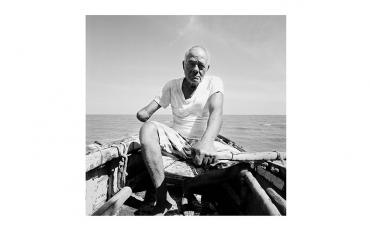
Photographic image in black and white, printed on canvas.
Measures 150cm x 150 cm
The image represents a man in the centre of the scene seated in a boat with his gaze directed at the viewer. He wears a white t-shirt illuminated by the sun. The trousers are striped and short to the knees.
The boat in which the man is seated shows signs of corrosion: on the left side of the image paint has scratched off the boat, revealing the wood underneath. The rope that is used to support the right oar is dangling, while on the left the elongated arm of the fisherman reaches out in the direction of the spectator while his fist tightens around the end of the oar. The gesture evokes the force of the thrust necessary to move the boat on the water.
The face is serious, the strong light of the sun that descends vertically casts shadows around his facial wrinkles.
While the left arm of the man is intent on pushing the oar, the right arm is raised and stands out on the left side of the image, showing an amputation just below the elbow.
He is framed by the sea and the clear sky which are divided at the height of the fisherman's torso. Under the sky you can see the ocean furrowed by the boat.
A phrase accompanies the photograph, it is a quote from the depicted man who says:“Every day I take to the sea.”
***
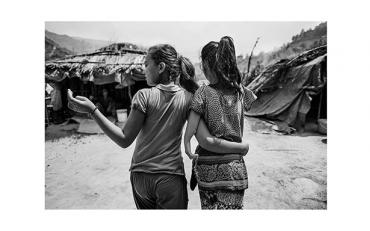
Photographic image in black and white, printed on fabric.
Measures 300 x 450 cm
The image represents two girls, visibly young, placed at the centre of the frame. The photograph is shot from the back as they walk away from the spectator with their arms wrapped around each other. They are walking toward some makeshift houses made of thatched roofs and nylon sheets placed above to serve as protection them from the heat and rain.
In the upper part of the image, at the left and right edges, it is possible to see barren land with a few trees scattered randomly. The ground on which the two girls walk is sandy.
The girl on the right side is dressed in a patterned short sleeved tunic typical of this region of Nepal and her trousers are made of the same pattern. As she is facing forward, it is not possible to see her face, but only her high ponytail. On the right side, the sleeve of her shirt is empty. Her left arm is wrapped around her friend’s right arm.
The girl on the left wears dark pants made of a soft fabric and a light coloured short sleeved t-shirt with a collar. Her hair is tied in a ponytail and her head is turned to the left, uncovering her profile and letting the viewer to see part of her face. Her left arm is extended towards the left side of the frame, a ray of light illuminates her forearm.
A phrase accompanies the photograph, it is a quote from the girl on the right:“My friends and I like to hang out together by the river in the afternoon.”
***
